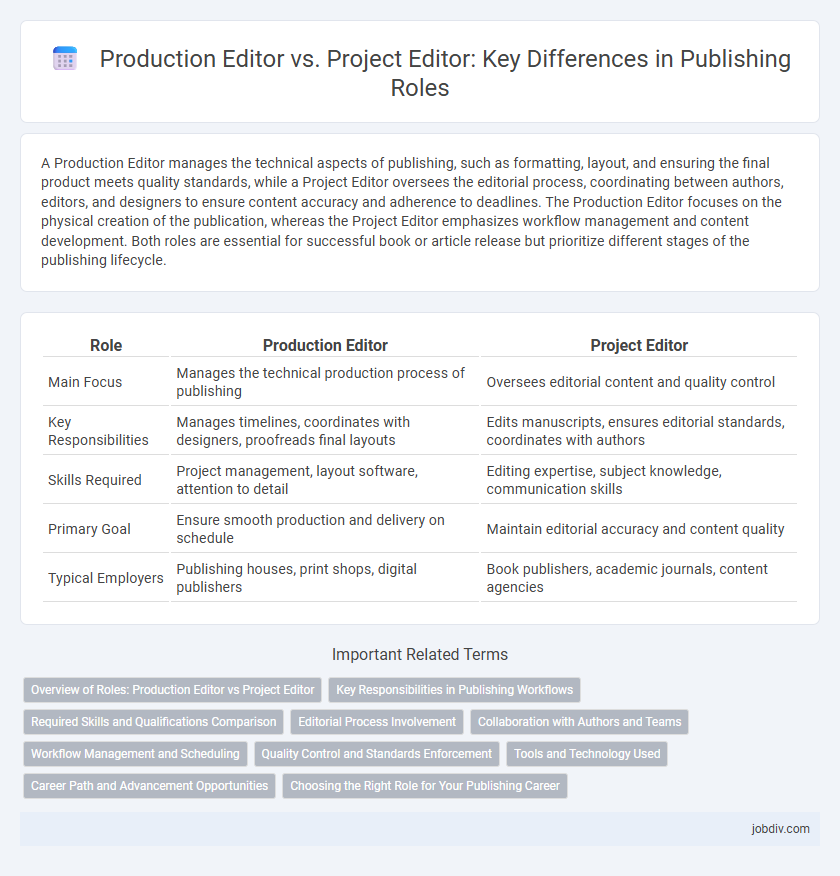A Production Editor manages the technical aspects of publishing, such as formatting, layout, and ensuring the final product meets quality standards, while a Project Editor oversees the editorial process, coordinating between authors, editors, and designers to ensure content accuracy and adherence to deadlines. The Production Editor focuses on the physical creation of the publication, whereas the Project Editor emphasizes workflow management and content development. Both roles are essential for successful book or article release but prioritize different stages of the publishing lifecycle.
Table of Comparison
| Role | Production Editor | Project Editor |
|---|---|---|
| Main Focus | Manages the technical production process of publishing | Oversees editorial content and quality control |
| Key Responsibilities | Manages timelines, coordinates with designers, proofreads final layouts | Edits manuscripts, ensures editorial standards, coordinates with authors |
| Skills Required | Project management, layout software, attention to detail | Editing expertise, subject knowledge, communication skills |
| Primary Goal | Ensure smooth production and delivery on schedule | Maintain editorial accuracy and content quality |
| Typical Employers | Publishing houses, print shops, digital publishers | Book publishers, academic journals, content agencies |
Overview of Roles: Production Editor vs Project Editor
A Production Editor manages the technical and logistical aspects of the publishing workflow, ensuring manuscripts are prepared for publication with a keen eye on formatting, proofreading, and quality control. A Project Editor oversees the entire editorial process, coordinating between authors, editors, designers, and printers to meet deadlines and budget requirements. While the Production Editor handles detailed execution, the Project Editor focuses on strategic planning and project management in publishing.
Key Responsibilities in Publishing Workflows
A Production Editor manages the technical aspects of the publishing process, including formatting, typesetting, and proofreading to ensure accuracy and quality control. A Project Editor coordinates editorial workflows, oversees timelines, and liaises between authors, reviewers, and the production team to maintain project milestones. Both roles are crucial for seamless publishing workflows, with the Production Editor focusing on content refinement and the Project Editor managing overall project execution.
Required Skills and Qualifications Comparison
Production editors require strong organizational skills, proficiency in project management software, and a keen eye for detail to oversee the entire publishing process efficiently. Project editors demand excellent communication skills, editorial expertise, and the ability to coordinate with authors, designers, and marketers to ensure content quality and timeline adherence. Both roles benefit from a background in publishing or communications, with production editors leaning more towards operational skills and project editors emphasizing content accuracy and collaboration.
Editorial Process Involvement
Production editors primarily manage the logistical aspects of the publishing workflow, including coordinating schedules, handling manuscript tracking, and ensuring timely delivery of editorial materials. Project editors engage deeply with the editorial content, overseeing substantive editing, collaborating with authors on revisions, and maintaining the integrity of the manuscript throughout the editing process. Both roles are essential, but project editors have greater involvement in the content's editorial development while production editors focus on operational execution.
Collaboration with Authors and Teams
Production editors coordinate closely with authors and design teams to ensure manuscripts meet publication standards and deadlines, focusing on managing schedules and technical details. Project editors collaborate deeply with authors, reviewers, and marketing staff to shape content quality and align the manuscript with the publisher's vision. Both roles require effective communication and teamwork to streamline the publishing process and deliver polished final products.
Workflow Management and Scheduling
Production Editors oversee the detailed workflow management of the publishing process, coordinating stages such as copyediting, typesetting, and proofing to ensure timely completion. Project Editors focus on scheduling by creating and maintaining project timelines, aligning editorial tasks with publication deadlines and stakeholder expectations. Their combined efforts streamline the publishing timeline, enhancing efficiency and reducing delays in book or journal production.
Quality Control and Standards Enforcement
Production Editors oversee the technical and design aspects of publishing, ensuring that manuscripts meet formatting specifications and maintain visual consistency throughout the production process. Project Editors focus on quality control by managing content accuracy, enforcing editorial standards, and coordinating revisions to uphold the publisher's editorial guidelines. Both roles collaborate to maintain high publication standards, with Production Editors emphasizing technical precision and Project Editors prioritizing content integrity.
Tools and Technology Used
Production Editors primarily use tools like Adobe InDesign, XML workflows, and digital asset management systems to oversee layout, typesetting, and final file preparation. Project Editors rely on project management software such as Asana, Trello, and Microsoft Project to coordinate editorial schedules, communicate with stakeholders, and track progress. Both roles increasingly incorporate collaborative platforms like Google Workspace and content management systems to streamline publishing workflows and enhance efficiency.
Career Path and Advancement Opportunities
Production Editors typically focus on the technical aspects of book production, such as coordinating layout, proofreading, and ensuring adherence to deadlines, offering career advancement into senior production roles or operations management. Project Editors manage the editorial workflow, overseeing manuscript development, coordinating between authors and stakeholders, and refining content quality, leading to opportunities in editorial management or publishing director positions. Understanding these distinct roles facilitates targeted skill development and strategic career growth within the publishing industry.
Choosing the Right Role for Your Publishing Career
Production editors manage the technical aspects of the publishing process, ensuring timely delivery, formatting consistency, and liaison with suppliers, making them ideal for candidates who excel in organization and workflow coordination. Project editors oversee the development of content from manuscript to final product, collaborating closely with authors, editors, and designers to maintain editorial quality and project timelines. Selecting the right role depends on your strengths in either operational efficiency or content-driven leadership within the publishing industry.
Production Editor vs Project Editor Infographic

 jobdiv.com
jobdiv.com